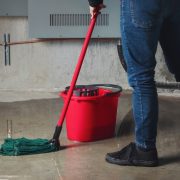Mold is a common problem in San Diego, CA, and it can be tough to get rid of once it takes hold. Is mold always visible? Not a chance, one of the biggest challenges is finding where mold hides.
Here Are 7 Places Where Mold Hides in San Diego

Basements and crawl spaces – Mold hides in basements and crawlspaces if the conditions are right. These areas may be prone to mold growth due to dampness, poor ventilation, and a lack of sunlight, which are all factors that can contribute to the development of mold. If you suspect that there may be mold in your basement or crawlspace, it is important to take steps to identify the problem and address it promptly to prevent it from spreading and causing health problems or damage to your home. If you are not sure how to identify or deal with mold, it is a good idea to seek the assistance of a professional mold remediation company or a certified mold inspector.
Attics – Attics can be particularly susceptible to mold growth due to their location at the top of a house, which can make them more prone to moisture problems. High humidity levels, leaks in the roof, and poor ventilation can all contribute to the growth of mold in attics. If you suspect mold hides in your attic, it is important to have it professionally inspected and tested to determine the type and extent of the mold present, as well as the best course of action for addressing the issue.
Behind walls – Mold hides in your walls? Mold can grow behind walls if there is a plumbing leak or other source of moisture. This can be difficult to detect, as the mold may not be visible until it has grown to a large size. Mold needs three things to grow: a food source, a source of moisture, and a suitable temperature. The food source can be any organic material, such as wood or drywall, and the temperature range for most types of mold is between 40 and 100 degrees Fahrenheit. If these conditions are present behind your walls, it is possible for mold to grow.
Underneath carpeting – Carpeting that is damp or has been wet for an extended period of time can become a breeding ground for mold. Carpets can retain moisture and provide an ideal environment for mold to grow. If the mold is found to be widespread or significant, it may be necessary to remove the carpet and treat the area to get rid of the mold.
Inside air ducts – If the air ducts in your home or business are not properly cleaned and maintained, they can become a breeding ground for mold. Mold can grow anywhere there is moisture, and air ducts can sometimes become damp due to condensation, leaks, or other sources of water. If mold begins to grow inside the air ducts, it can spread throughout the ventilation system and potentially release spores into the air that you and your family are breathing. It is important to keep your air ducts clean and dry to prevent the growth of mold. If you suspect that there may be mold growing in your air ducts, you should have them inspected and cleaned by a professional.
On windowsills – Windowsills are a common location for mold to grow, especially if they are not properly sealed or if they are exposed to a lot of moisture. Leaking windows and condensation are the two leading causes of the buildup of mold on a windowsill.
In showers and bathtubs – Mold can grow in showers and bathtubs when the conditions are right. Mold spores are present in the air all around us and they can land on any damp or wet surface. If the surface is not cleaned and dried properly after use, the mold spores can start to grow and multiply. Mold grows best in warm, damp, and humid conditions, so a shower or bathtub that is not properly ventilated can create the perfect environment for mold to grow. In addition, if there are any leaks in the plumbing or around the shower or bathtub, this can also contribute to the growth of mold. Underneath kitchen and bathroom sinks – These areas are often damp, making them a good location for mold to grow.
You might also like: 11 Ways to Prevent Mold in San Diego
How to Find Hidden Mold in Your House
Here are a few ways to find mold in your house:
- Look for visible signs of mold growth, such as discoloration on walls, ceilings, or floors. Mold can appear as black, brown, or white spots, and can have a musty or unpleasant smell.
- Check areas that are prone to moisture, such as around leaks in the roof or pipes, around windows and doors, and in basements and crawl spaces.
- Use a moisture meter to measure the humidity in your home. Mold thrives in damp environments, so high humidity levels could indicate a mold problem.
- Consider hiring a professional mold inspector to assess your home for mold. They have the training, experience, and specialized equipment to identify hidden mold growth and recommend a course of action.
If you do find mold in your house, it’s important to address the problem as soon as possible to prevent it from spreading and causing health problems.
Is Mold Hiding in Your Home or Business?
If you suspect that you have a mold problem in your San Diego home or business, it is important to take action as soon as possible. A professional mold remediation company like Gold Coast Flood Restorations can help you find where the mold hides and develop a plan to get rid it.









Also find us on…